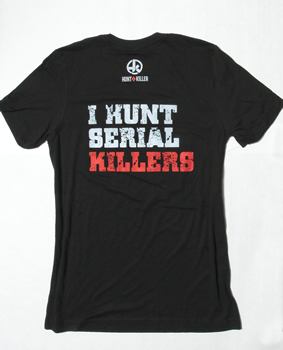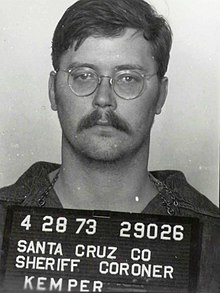

Trend Alert: Is There a “New” Serial Killer Fascination?
 By Dawn Ius
By Dawn Ius
Meaghan Ellis is fascinated by serial killers. Not just the ones in real life, but the kinds she reads about in fiction. She wants to know what makes them tick. What makes them start. What makes them stop.
Whether she—in the wrong place at the wrong time—could become a victim.
It’s not the kind of fascination that led her to a career in forensics or anything, but these are the novels that line her bookshelf, and it’s the reason she registered for a somewhat macabre subscription box—one that delivers a package to her house each month…from a serial killer.
“Oh, I know it’s just fictional,” she says. “But it’s kind of a safe thrill—a chance to be like the F.B.I. profilers on TV, or the cops in my favorite novels.”
Ellis isn’t alone. More than 53,000 people are active on the Hunt A Killer closed Facebook group, and at last tally on the website, almost 20,000 enthusiasts had signed up to receive their monthly package of photographs, clues, and letters.
Subscription boxes aren’t new. But Hunt A Killer is the first of its kind that promises to take you deep inside the mind of a serial killer as you “solve the murder of a lifetime.” It’s also another strong piece of evidence that proves society continues to be fascinated by these kinds of criminals—and there are chilling new ways to tell these stories, an open door, perhaps, for a “fresh generation” of thrillers about serial killers.
Exploitive, perhaps, but even that isn’t unique. Every murderer from Jack the Ripper to Ted Bundy and beyond has been re-imagined in novels, non-fiction, film, television and video games. And while interest tends to go up and down in waves, there’s a reason why a thriller or mystery around a serial killer is as commercial, or more successful, than ever.
Or, as forensic psychologist Dr. Jessica Driscoll points out, a couple of reasons.
“When a murder happens, we’re briefly worried, or concerned about our lives,” she says. “Especially if we can identify with the victim somehow—geographical location and demographic similarity, for instance.”
That fear heightens when the killer isn’t caught, but perhaps even more so when the killer’s MO is less obvious, even random, such as the case with Ted Bundy—a seemingly charismatic, attractive man with a relatively good social upbringing.
The idea that this man—someone who confessed to more than 30 homicides—could have been our next-door neighbor, or in Bundy’s case, the man who answered the phone at the other end of a suicide crisis line, is frightening.
And to many—utterly fascinating.
“A lot of that has to do with motivation,” Dr. Driscoll says, noting that while other violent crimes, such as rape, spark fear, society has a harder time understanding repetitive homicide. “When we talk about physical drives, sex is up there, so we can wrap our head around that. But what motivates you to cut people open and eat them?”
Thomas Harris explored that in his Hannibal Lecter books, a series that arguably opened the floodgates for the serial killer trope in fiction and film. Thanks to Harris’ vivid writing, and Anthony Hopkins’ incredible acting, Lecter remains one of the most recognizable serial killers on page and screen. But hundreds of authors have followed suit.
Bestselling author Meg Gardiner’s 2017 release, UNSUB was inspired by her childhood fear of the still-unidentified Zodiac Killer, and the second installment in her series, INTO THE BLACK NOWHERE, revisits Ted Bundy’s homicides—timely, perhaps, given the forthcoming Bundy movie starring Zac Efron.
Author Valentina Giambanco has also written about serial killers in her Seattle homicide series featuring Detective Alison Madison—though she admits she didn’t draw inspiration from real case files. It’s the investigation behind the homicides—the profiling—that fascinates her, and for that kind of research, she turned to the ultimate source: John Douglas.
You’d almost have to be living under a rock to not be familiar with Douglas—his work on serial killers created an entire department at the FBI dedicated to profiling them, and his research became the foundation for one of Netflix’s most compelling shows. In MINDHUNTER, the characters—and the viewers—are taken through the brains of some of the most horrific killers behind bars. The show is based on Douglas’ bestselling books, which Giambanco says are sometimes difficult to read.
“The cases (Douglas) worked on over decades were simply horrifying,” she says. “The banality and everyday nature of real life evil is too dark for me. I much prefer to work with compelling fictional characters who—amongst other things—happen to enjoy killing people. After reading John Douglas’ book, it’s pretty clear that real life can be stranger, darker, and altogether scarier than we can make it on the page.”
Those who succeed understand the precarious balance of creating villains that are both evil and sympathetic, a writing rule for all antagonists, but perhaps even more challenging when it comes to the profile of a serial killer. Harris nails it in Silence of the Lambs, and Chelsea Cain shows us a terrifying murderess in her brilliant Heartsick series featuring Gretchen Lowell.
 This type of criminal has also been profiled in young adult fiction—from S.E. Green’s Killer Instinct books about a young Dexter-like character, to Kerri Maniscalo’s 2016 release, Stalking Jack the Ripper, it’s evident that our fascination for serial killers spans every age and reader demographic, including non-fiction books, podcasts, and documentaries.
This type of criminal has also been profiled in young adult fiction—from S.E. Green’s Killer Instinct books about a young Dexter-like character, to Kerri Maniscalo’s 2016 release, Stalking Jack the Ripper, it’s evident that our fascination for serial killers spans every age and reader demographic, including non-fiction books, podcasts, and documentaries.
Last year, author and reporter Claudia Rowe published her part-memoir, The Spider and the Fly, a riveting and raw look at her intimate conversations with Kendall Francois, a painfully polite 27-year old community college student who strangled eight women and lived with their corpses rotting in his attic.
For New York Times bestselling author Christopher Rice, whose new novel BONE MUSIC also deals with serial killers, he’s less interested in the murderers behind bars than the thousands of unsolved homicides that haven’t yet been linked to serial crime.
“My fear is that there are more serial killers out there than we know about, murderers about whom we have no psychology or forensic data—that’s scary. But personally, I don’t think the serial killer is as fascinating as the damage he does to the victims.”
Of course, these examples are all just drops in the bucket of a seemingly endless well of serial killer media. A trend that Dr. Driscoll acknowledges will continue to ebb and flow—but never really go away.
“We’re constantly using new technologies to review evidence,” she says, pointing to one example—a super computer that was developed to analyze the notes left by the Zodiac Killer. “And people are always finding new ways to tell the story. We’re getting smarter about marketing to that fascination. Because in the end, we all want to be the one to solve the murders…to be the one to catch the killer.”
- On the Cover: Alisa Lynn Valdés - March 31, 2023
- On the Cover: Melissa Cassera - March 31, 2023
- Behind the Scenes: From Book to Netflix - March 31, 2023


